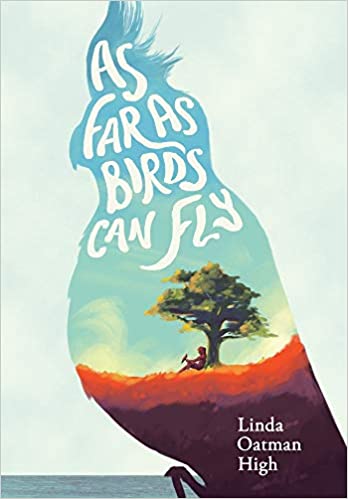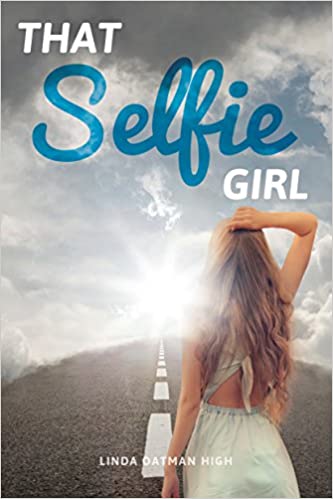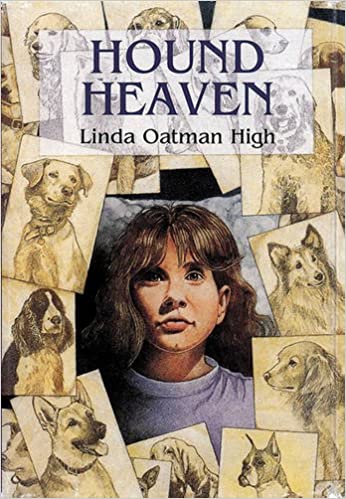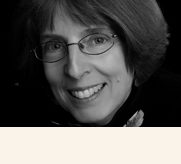
Linda Oatman High has written more than twenty books for young readers, and here is her latest. Don’t you just love the cover?
As Far As Birds Can Fly hit shelves last month, and today Linda is here to talk all things writing-related. But first, the giveaway, of course! You know the drill: hop to the end of this post to sign up, then come on back to read a bit about Linda’s process in writing this heartwarming story about an almost-twelve year-old girl and a pet cockatiel who’s gone missing. Deadline to enter: Tuesday, January 19, 2021, at 11:59 PM.
A. B. Westrick: Linda, welcome to my blog!
Linda Oatman High: Thanks for doing this interview! Great to be here.
ABW: Let’s start with the setting, the fictional town of Murdock, Mississippi. Now, I happen to know you live in Pennsylvania, so tell me about your decision to set the story where you did. (By the way, I love the bumper sticker on the mirror in the fictional beauty salon: American by birth, Southern by the grace of God.) Would it have been a different story if you’d set it in Pennsylvania?
LOH: I set the story in Mississippi, as I really wanted a Southern girl to be the protagonist. I knew that I wanted to write in some manner about racial tensions that linger, and about a small Southern town in which people who are “different” might have a hard time being accepted. I also wanted to write about grief, which is a universal life experience, and the Southern beauty salon appeared. My brother and I used to go with our mom to the beauty salon, where we’d sit in the waiting area and observe the ladies under hair dryers, chatting away. It was easy to take that Pennsylvania memory and move it south.
ABW: Oh, you poor thing, having to wait in the beauty salon. But I guess it gave you great material for fiction! Did you travel to Mississippi for research?

LOH: I often travel for research, but not this time. Well, at least not to Mississippi. I began this story at a writing retreat in a cabin in the Carolina mountains, where a friend with a Southern accent (Wayne Yonce, to whom the book is dedicated) took me on a tour of his home. He had an adored pet cockatiel. “This is Third Bird,” said Wayne in his charming southern drawl. “First there was Bird, then there was Bird-Bird . . .” The story took off from there.
ABW: I love that! And now I know where you got the curious names you used in the book. When you visited with Wayne, I assume that was before the pandemic lockdown, yes? (No?) Have you traveled much at all since last March? In general, when you write stories, how do you go about doing research for settings and/or other elements of your fiction?
LOH: It was long before the pandemic when I visited Wayne in NC. I’ve only traveled since lockdown on a couple vacations with close family/friends: Lake Ontario in June, my friend Marty’s house in July, beach with family. I miss traveling and have wanderlust!

In general, I do like to travel to the place about which I write, and immerse myself in the area’s sights and smells and sounds. When I wrote my last middle-grade novel, One Amazing Elephant, set in Gibtown, Florida, I traveled there to see the trailer park for retired sideshow performers.
ABW: Oh… so there’s a trailer park for retired performers. Who knew? And of course, that’s the point: traveling to get the details right. Excellent.
Now I want to ask about your protagonist in As Far As Birds Can Fly. Magnolia. I found her story heartwarming, especially in the way it opens with a glimpse of her grief over her dad’s death. Then the scene shifts to Magnolia and her mom. She hates that Mom comes “from a long line of beauty queens” and wants Magnolia to enter pageants. Do you see in Magnolia the girl you used to be? How much are you and she alike? Or perhaps the question is: how do you go about crafting your fictional characters?
LOH: Magnolia is very much like me, in that I don’t spend much time on makeup, hair, and other “girly” routines. I grew up playing guitar, so I don’t get manicures. I often wear whatever is on top of the clean laundry pile, not putting much thought or energy into deciding what clothes to wear. I was a tomboy as a kid: riding motorcycles, snowmobiles, and four-wheelers, playing in the woods, climbing trees. Oh, and reading . . . just like Magnolia.
She also dresses like me: bib overall shorts and Converse sneakers. At the age of 62, that is STILL my summer wardrobe. My mom was (and is) much more of a “girly-girl,” so, yes. Magnolia is me. When I was hired for my first office job, my mom took me shopping to try to make me look professional and polished in pantsuits and heels. It didn’t work. I was a hippie chick, and still am to this day. I’m known for Converse and combat boots; forget about heels. I’d trip and fall.
ABW: Love it. Ha! All right, now let’s talk about your writing process. Are you a plotter or a seat-of-your-pantser? When you sit down to begin a brand new story, where/how do you start?

LOH: I’m definitely a pantser. I often start with an image, a line of dialogue, a character, or a setting. Over the years, I’ve tried to learn more about being a plotter, as I think it prevents my common problem of quitting 20 pages into the book. I took a one-day class a few years ago, called Save The Cat, and that has been the most valuable tool in learning a bit about how to actually think about plot before (and while) writing.
ABW: I took a Save the Cat class, too! Good stuff. (Recently when I interviewed author Robin Farmer, she also mentioned Save the Cat. We must all be drinking the same water.)
What is your process like? Do you write in the mornings, evenings, or all day long? Do you have any writing rituals like lighting candles or listening to music?
LOH: I have no writing routines or rituals, which probably is an effect of writing while raising kids and taking care of grandchildren. I began my career as a newspaper writer, so I write fast when I do write. I write when the mood strikes, or when I’ve managed to pry myself away from Netflix, Facebook, and other entertainment. I have a Writing Barn in my backyard, which is where I most often write these days. It was my grandparents’ barn, built in the 1800s, and a developer was going to bulldoze and landfill it. My husband (AKA “The Barn Saver“) dismantled it, tagged and blueprinted, and rebuilt it at the end of our half-acre back yard.
ABW: Oh, that’s wonderful. I just found his website, The Barn Saver: Reclaiming Barns Since 1990. Fabulous! He sounds like one-in-a-million.
LOH: He is! And now that barn is my Quiet Place. In it, I have candles, incense, my bass guitar and amp, a medical skeleton, a coffeemaker, and a record player. I also have a sofa (writers need naps, you know), a recliner, a Sky Chair hanging from the ceiling, and an antique rocker from my BFF Marty Crisp. And a desk chair, but that’s the last choice for seating options.
ABW: I LOVE that you mention Marty Crisp here and in your Acknowledgements. I met you two at the same time and always when I think of one of you, I think of both.
Okay, new question: into what sort of well do you dip for ideas? For inspiration? Where do your stories come from?
LOH: My Idea Well is always overflowing; I have way more ideas than I have time or motivation or energy. Sometimes the ideas come from my childhood, such as when I wrote The Girl on the High-Diving Horse about the diving horses of Atlantic City, New Jersey. My family went there often, and the images and sensory details stuck with me. Another idea from childhood was my first middle-grade novel, Maizie, about a girl who wants a strawberry roan pony.

My middle-grade Hound Heaven started when my oldest son wanted a dog and began clipping pictures from newspaper rescue animal ads. My YA novel Sister Slam and the Poetic Motormouth Road Trip started with memories of my teenage days and driving my 1969 Mustang muscle car.
Sometimes ideas come from a line of dialogue heard in real life, such as Wayne Yonce introducing me to Third Bird. When my youngest son was 14, he liked to visit nursing homes and cheer elderly people. One time a lady, drooling in a wheelchair, motioned for him to bend down to her. He did (gingerly; he thought he was going to be hit), and she gently stroked his chin. Looking up at him with watery old eyes, the lady said, “I love the feel of chins.” That line, which I never could have invented, created a short story that was published.
I’ve had ideas at school visits, in the grocery store, in trains and planes and automobiles, in bed at night, in the shower, while walking, cooking, cleaning. Ideas are everywhere in the universe, floating around for all artists and writers and musicians to grab.
ABW: I still remember the day we met at Vermont College of Fine Arts. We were in the MFA program in writing for children and young adults, and at that time, you’d already published a number of books, receiving both starred reviews and awards. You already had a successful career, so why did you decide to return to school for an MFA? What did that program do for you that you weren’t already doing?
LOH: Going to school for an MFA in writing was a longtime dream for me, and to achieve that goal was a wonderful feeling. I’d wimped out on college at the age of 18, getting married instead, which broke my dad’s heart. When I graduated from Vermont College, Dad wrote me a card in his shaky old-man handwriting: “I’ve waited a long time for this.” I’m so glad that he got to know that I finally did it before he passed. Dad was too ill to attend my graduation, but my mom and stepdad were able to come, as were my husband and youngest son.

Writers can always improve, learn, and grow, and what I learned at Vermont College changed my writing in ways that I cannot define. After I graduated from VCFA in 2010, I wrote a short story that went on to be on the shortlist of the EFG Short Story Award in England.
ABW: Oh, congratulations! That’s a big award.
LOH: Thank you. Yes, it was an honor. I was the only American on the shortlist of six authors. I’d written about the Amish school shootings that happened not far from my home in Lancaster County, Pa. In the MFA program, one of my advisors—Louise Hawes—had told me to write about what scares me. So I did.
ABW: Good thing you did. (Louise Hawes was one of my advisors at Vermont, too. She’s awesome!)
Okay, last question: what are you working on now?
LOH: I’m working on a middle-grade novel about a girl struggling with her big brother’s illness, and also a YA about two teens who fall in love across the air. I’m also working on a YA verse novel about the life of Kurt Cobain, one of my musical heroes, AND a middle-grade verse novel set after the Holocaust.
ABW: Multiple projects at once.
LOH: I get bored easily, so I’ve always hopped around between projects. I tried for a long time to fight that habit but it didn’t stick. Finally I decided that I’d produced plenty of books and projects while “hopping,” so I’d just keep on jumping around. I think that this instinct comes from the fact that I do have too many ideas, and sometimes new ones are all shiny and exciting and they won’t leave me alone until I begin writing. Ideas are like toddlers: they nag and create chaos until you pay attention to them.
ABW: Haha, that’s great! Thank you so much, Linda. I’ve loved catching up with you.
LOH: Same here!
Readers who want to know more about Linda Oatman High can follow her on Twitter and find her at her website and on facebook. If you visit Linda on social media, please be sure to say so in the rafflecopter below. Each entry gets you a chance to win a copy of As Far As Birds Can Fly. The deadline to enter is Tuesday, January 19, at 11:59 PM. Good luck!

An interesting interview. The writer is clear about who she is and what she wants. I’m not surprised she has been successful with her writing.
Yes, Lenore, that clarity. Sometimes I wonder if I would have more clarity about my own writing if I’d seen myself as a writer at an age younger than 50-something. I’m glad I eventually found my way, even though I didn’t find it early. I started writing when my youngest started kindergarten — and by that time I wasn’t “young” anymore. Ahhhh, but no regrets…
So lovely to see Linda featured here and to read about her process (love the multiple projects route). How cool to have a writing barn! I also am not surprised that Linda has written as many books as she has. 😄
I’d love to have that writing barn!
Thank you for the interview! I’m so happy that Magnolia is out in the world and readers will get to meet her! I remember her from our VCFA workshop together years ago. And keep me posted about the Kurt Cobain verse novel because he’s one of my (many) musical heroes too. (Another is Joe Strummer, who shows up in my verse novel.)
I love hearing that you “met” Magnolia in a VCFA workshop many years ago. It’s something how long characters float around in our heads and walk through our lives before they eventually appear on pages and go out into the world.
I’m SO excited to see this book coming out now! Congratulations, and Happy Book Birthday to a fellow VCFA-er!
The VCFA connection makes it that much more fun, doesn’t it? All in the family…